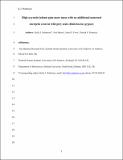Files in this item
High oxytocin infants gain more mass with no additional maternal energetic costs in wild grey seals (Halichoerus grypus)
Item metadata
| dc.contributor.author | Robinson, Kelly J. | |
| dc.contributor.author | Hazon, Neil | |
| dc.contributor.author | Twiss, Sean | |
| dc.contributor.author | Pomeroy, Patrick | |
| dc.date.accessioned | 2020-08-26T23:33:58Z | |
| dc.date.available | 2020-08-26T23:33:58Z | |
| dc.date.issued | 2019-12 | |
| dc.identifier | 251694168 | |
| dc.identifier | 41d9f082-2eb4-434c-8ce1-b0795a95fddd | |
| dc.identifier | 85071601944 | |
| dc.identifier | 000500388600029 | |
| dc.identifier.citation | Robinson , K J , Hazon , N , Twiss , S & Pomeroy , P 2019 , ' High oxytocin infants gain more mass with no additional maternal energetic costs in wild grey seals ( Halichoerus grypus ) ' , Psychoneuroendocrinology , vol. 110 , 104423 . https://doi.org/10.1016/j.psyneuen.2019.104423 | en |
| dc.identifier.issn | 0306-4530 | |
| dc.identifier.other | ORCID: /0000-0003-1603-5630/work/61369942 | |
| dc.identifier.other | ORCID: /0000-0002-6212-9710/work/75996847 | |
| dc.identifier.uri | https://hdl.handle.net/10023/20517 | |
| dc.description | The UK’s Natural Environmental Research Council (NERC) funded the long-term program of research on grey seals at North Rona and the Isle of May. PPP and SDT were in receipt of NERC grant NE/G008930/1 and PPP was in receipt of Esmée Fairburn Foundation grant 08-1037 during the work. This paper formed part of KJR’s PhD funded by the UK Natural Environment Research Council (NERC) grant NE/H524930/1 and by SMRU Marine, St Andrews, UK. | en |
| dc.description.abstract | Maximising infant survival requires secure attachments and appropriate behaviours between parents and offspring. Oxytocin is vital for parent-offspring bonding and behaviour. It also modulates energetic balance and neural pathways regulating feeding. However, to date the connections between these two areas of the hormone’s functionality are poorly defined. We demonstrate that grey seal (Halichoerus grypus) mothers with high oxytocin levels produce pups with high oxytocin levels throughout lactation, and show for the first time a link between endogenous infant oxytocin levels and rates of mass gain prior to weaning. High oxytocin infants gained mass at a greater rate without additional energetic cost to their mothers. Increased mass gain in infants was not due to increased nursing, and there was no link between maternal mass loss rates and plasma oxytocin concentrations. Increased mass gain rates within high oxytocin infants may be due to changes in individual behaviour and energy expenditure or oxytocin impacting on tissue formation. Infancy is a crucial time for growth and development, and our findings connect the oxytocin driven mechanisms for parent-infant bonding with the energetics underlying parental care. Our study demonstrates that oxytocin release may connect optimal parental or social environments with direct physiological advantages for individual development. | |
| dc.format.extent | 7 | |
| dc.format.extent | 807812 | |
| dc.language.iso | eng | |
| dc.relation.ispartof | Psychoneuroendocrinology | en |
| dc.subject | Maternal bonding | en |
| dc.subject | Infant bonding | en |
| dc.subject | Infant development | en |
| dc.subject | Positive feedback loop | en |
| dc.subject | Mass gain | en |
| dc.subject | Parental investment | en |
| dc.subject | QH301 Biology | en |
| dc.subject | DAS | en |
| dc.subject | NERC | en |
| dc.subject.lcc | QH301 | en |
| dc.title | High oxytocin infants gain more mass with no additional maternal energetic costs in wild grey seals (Halichoerus grypus) | en |
| dc.type | Journal article | en |
| dc.contributor.sponsor | NERC | en |
| dc.contributor.institution | University of St Andrews. Marine Alliance for Science & Technology Scotland | en |
| dc.contributor.institution | University of St Andrews. Scottish Oceans Institute | en |
| dc.contributor.institution | University of St Andrews. School of Biology | en |
| dc.contributor.institution | University of St Andrews. Sea Mammal Research Unit | en |
| dc.contributor.institution | University of St Andrews. Centre for Research into Ecological & Environmental Modelling | en |
| dc.identifier.doi | https://doi.org/10.1016/j.psyneuen.2019.104423 | |
| dc.description.status | Peer reviewed | en |
| dc.date.embargoedUntil | 2020-08-27 | |
| dc.identifier.grantnumber | NE/G008930/1 | en |
This item appears in the following Collection(s)
Items in the St Andrews Research Repository are protected by copyright, with all rights reserved, unless otherwise indicated.

